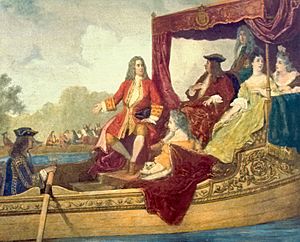Water Music (Handel) facts for kids
The Water Music is a famous collection of music pieces. They were written for a Baroque orchestra by George Frideric Handel. This music is made up of three main parts, called suites.
These suites include different types of dances. You can hear minuets, hornpipes, and bourrées, among others. In total, there are three suites (in F major, D major, and G major). They contain 21 individual pieces of music.
What is Handel's Water Music?
The Water Music is a well-known group of songs. It was created by the famous composer George Frideric Handel. He wrote it for a special type of music group called a Baroque orchestra.
This collection of music is divided into three main sections. Each section is like a mini-concert with several different songs. Many of these songs are based on popular dances from Handel's time.
A Royal Boat Trip
A popular story tells us how the Water Music was first played. It happened on July 17, 1717. King George I of England was taking a boat trip. He was sailing up the Thames in London. The trip was going towards Chelsea or Lambeth.
The King had known Handel for a long time. Some stories say they had a disagreement. This music was Handel's way of making things right with the King.
Fifty musicians floated on another boat right next to the King's barge. They played the Water Music suites. The King loved the music so much! He asked for it to be played three times during the trip.
Another story says Handel wrote the music for a party the King was having. The King wanted music for himself and his friends to enjoy while sailing. This is why it's called "Water Music."
Instruments Used
Handel wrote the Water Music for a full Baroque orchestra. Almost all the instruments from that time were included. However, the harpsichord and timpani (kettledrums) were not used. It would have been very hard to bring these large instruments onto a boat!
For a complete performance today, the music uses several instruments. These include a flute, two recorders, and two oboes. There is also one bassoon, two horns, and two trumpets. Strings (like violins and cellos) and a continuo (a bass line played by instruments like cello and bassoon) are also part of the group.
See also
 In Spanish: Música acuática para niños
In Spanish: Música acuática para niños


